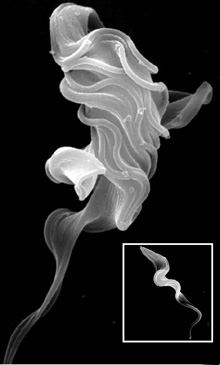African Sleeping Sickness Breakthrough

Researchers have made a crucial breakthrough in the journey towards finding a treatment for African Sleeping Sickness.
The team of researchers from Lancaster, Oxford and Manchester Universities have discovered a weakness in the parasite that causes the disease - it cannot survive in the human bloodstream without the use of its flagellum, a protein 'tail' that allows it to swim.
This unexpected discovery offers up a valuable lead in the search for new drugs to control the killer disease.
The study is published this week (March 9) in the leading scientific journal Nature.
The sleeping sickness parasite, Trypanosoma brucei, is a single-celled organism equipped with a whip-like tail or flagellum. The parasite initially lives in the bloodstream of the human host causing fever and headaches, but eventually crosses into the brain where it causes irreversible neurological damage. Without treatment, the disease is fatal.
According to the latest figures from the World Health Organisation (WHO), African Sleeping sickness threatens over 60 million people in 36 countries of sub-Saharan Africa. The number of new cases per year is estimated to be between 300,000 to 500,000 with at least 60,000 people dying annually from the disease.
Until now doctors have struggled to treat the disease as most of the drugs currently used to combat this disease have undesirable side-effects and parasites are beginning to show evidence of increasing drug resistance. Furthermore there is little hope of a vaccine.

“We also show that many of these proteins are specific to the trypanosome flagellum. This latter finding is of critical importance since we also show that flagellum function is essential to the survival of bloodstream trypanosomes. These two observations raise the possibility that the flagellum may represent a novel target for the development of new drugs against this important medical pathogen.”